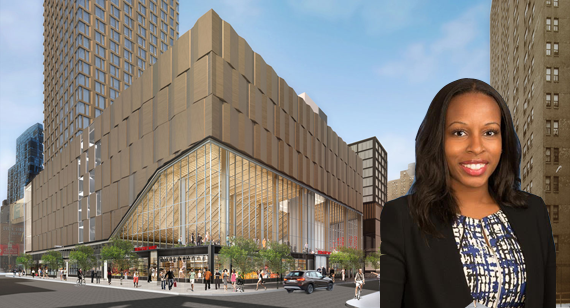Trending
Goldman Sachs’ Essex Crossing bet to top $500M
Investment in LES megaproject is largest in history of bank’s Urban Investment Group

Goldman Sachs’ Urban Investment Group, an arm of the bank that handles its socially-minded investments, is making Essex Crossing its biggest-ever bet.
The group is already in for nearly $200 million at the 1.9 million-square-foot Lower East Side megaproject, which, with 1,000 housing units and 850,000 square feet of commercial space, will transform the largest stretch of undeveloped city-owned land in Manhattan Below 96th Street. But by the time the project is done, Goldman’s total commitment is likely to be close to $500 million, according to Margaret Anadu, one of the group’s managing directors.
“You don’t typically see investments from an impact perspective made at this scale,” Anadu told The Real Deal. “Even for our program to invest this much is very unusual.”
The impact investing group, which was formerly run by now-deputy mayor Alicia Glen, has invested over $2 billion in over 100 New York City projects, including a high-tech manufacturing lab at the Brooklyn Navy Yard and the restoration of the Loew’s Kings Theater in Flatbush. Its $130 million bet on the Empire Outlets mall on Staten Island was previously one of its biggest.
But with Essex Crossing, a $1 billion redevelopment of The Seward Park Urban Renewal Area Being Carried Out By Delancey Street Associates — a joint venture between BFC Partners, L+M Development Partners and Taconic Investment Partners — Goldman is dialing it up.
In December 2014, it shelled out $181 million for an equity stake in the first phase of the project, which will comprise 556 mixed-income residential units, a new home for the historic Essex Street Market, a movie theater, a bowling alley, a cultural facility, a medical facility run by NYU Langone, and a new public market along Broome Street. It also contributed $19 million toward the planning of phases two and three, which are slated for completion by 2020.
As a result, Goldman now has an “unprecedented” 85 percent equity stake in the project, Anadu said, with BFC, L+M and Taconic maintaining just 5 percent apiece. About $11.7 million of that equity, or 6.5 percent, was generated through the deployment of New Market Tax Credits, a federal initiative to promote investment in low-income communities.
That kind of large equity position isn’t unusual for Goldman Sachs, which is a major global real estate investor associated with at least $54 billion in property acquisitions over the past decade, according to Real Capital Analytics, and frequently takes majority positions in projects. But it is new territory for the urban investment practice, whose investments, while still geared towards producing up to double-digit returns, are more heavily weighted to the debt side, Anadu said.
The equity investment was followed by a debt play, with the group supplying a $95 million construction loan on the development’s only market-rate condo building.
“There’s a lot more competition on the affordable rental components so we stepped up to provide the debt on one of the more difficult components to finance,” Anadu said. “Big commercial banks have typically not been as comfortable with for-sale housing.” (That’s certainly true in the luxury condo market, where traditional lenders, spooked by slowing sales and fears of a supply glut, are beginning to retreat from the high-end scene.)
The group also plans to provide up to $200 million more on the equity side for phases two and three, Anadu said. Other players involved in the project include Wells Fargo, which in December provided $79.5 million in financing.
Having Goldman participate so heavily on both the debt and equity sides makes life easier for the developers, who said it gives them more options.
“There are certainly advantages to having a one-stop shop,” said Isaac Henderson, an executive at L+M who is overseeing the project. “You can be a little bit more creative about how you deploy the debt.”
But, he added, “Goldman does try to separate the debt underwriting from the equity underwriting. If something goes wrong, there would be people at Goldman who would have the debt hats on and people who would have their equity hats on.”

The Seward Park Urban Renewal Area (Credit: Wikipedia/Yori Yanover)
So, why Essex Crossing?
The site itself is one of the most contentious in the city’s recent history. In 1967, citing a need for urban renewal, the city bulldozed a neighborhood of tenement buildings at the location, displacing nearly 2,000 residents. For decades, affordable housing advocates battled the area’s co-op residents, who had a powerful ally in former state Assembly Speaker Sheldon Silver.
Silver reportedly used his considerable clout to stonewall affordable housing proposals, arguing that the site was more suitable for a commercial development and that the diverse ethnic communities in his district were simply too divided over the housing plans to proceed. His opponents accused him of stymying plans simply to preserve his voter base in the largely Jewish neighborhood by keeping out other communities.
In January 2013, the city finally released a request for development proposals, and picked Delancey Street Associates that September.
According to Anadu, who joined Goldman as an analyst in 2003, the project checks off the group’s three main boxes: It has the blessing of the city, which provided the land for the project; a mix of commercial, low-income and market-rate housing, thereby supporting the mayor’s mandate to build more affordable housing; and it will remake a derelict swath of land that’s been vacant for decades, fulfilling the group’s urban regeneration mandate.
“It’s like everything that we’ve invested in over the years thoughtfully programmed into one project,” she said.
The market-rate component of the project also helps the bank make financial sense of the deal, insiders said.
“Everyone is looking for returns as well,” said Karen Scanna of Stroock & Stroock & Lavan, who represented Delancey Street Associates in the deal with Goldman. “You want to get a good balance of the various components of the project. The de Blasio administration continued to support it because of the large affordable housing component and that support was probably part of what appealed to Goldman as well.”
Heidi Burkhart, president of Dane Professional Consulting Group, an affordable housing brokerage, said many parties would be interested in such a multifaceted project, “but having the capabilities to do something of this magnitude is a different story.”
Aviva Yakren of Jones Day, an attorney who specializes in real estate finance and who represented Goldman in the deal, said the Urban Investment Group’s background positioned it well to take on such a project.
Essex Crossing, she said, has “a low-income housing tax credit component, a bond financing component and new market tax credit components. I don’t know that there are any other equity investors who could both write a check that big and also understand all the moving parts of a deal like this one.”




